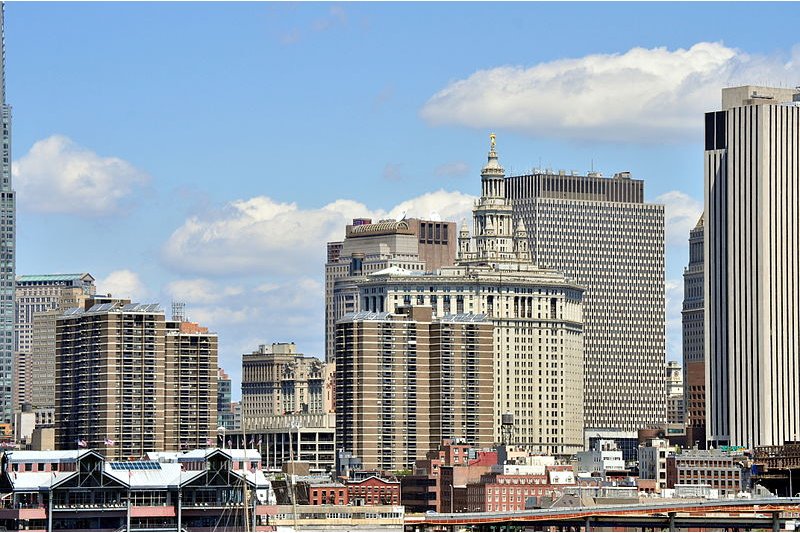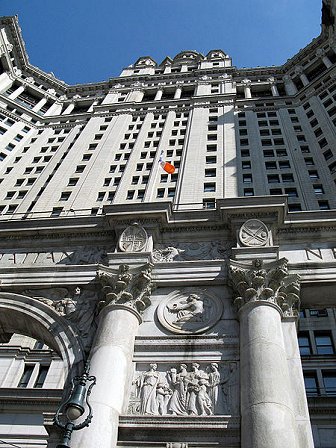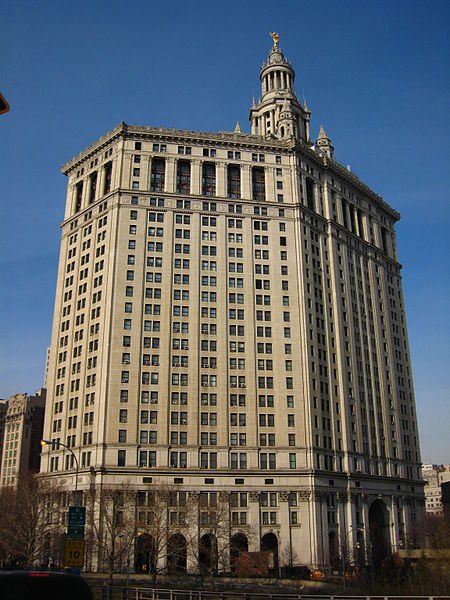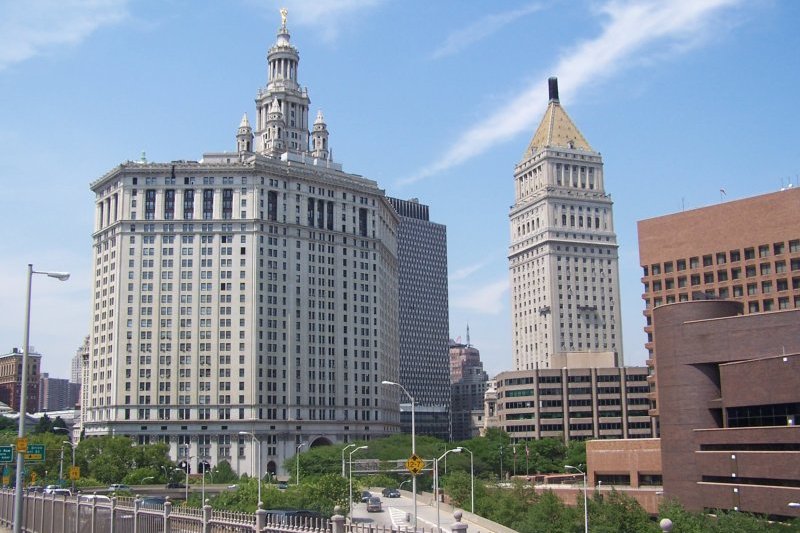

Manhattan Municipal Building
 Go Back - Latest New York City > USA > Americas > World | YouTube : Facebook | About Me : Contact Me
Go Back - Latest New York City > USA > Americas > World | YouTube : Facebook | About Me : Contact Me Manhattan Municipal Building
Manhattan Municipal BuildingSource: https://commons.wikimedia.org/wiki/File:Manhattan_Municipal_Building_etc._seen_from_Brooklyn_Heights_01A_(9423330878).jpg
Author: Joe Mabel

Located at the intersection of Chambers Street and Centre Street, the Manhattan Municipal Building is one of the largest governmental buildings in the world. It houses thirteen municipal agencies of New York City. This is where the people of Manhattan come to register their marriage - 28,000 does so every year. There are 25 floors of work space served by 33 elevators with an additional 15 stories in the tower.
History of the Manhattan Municipal Building
The government of New York City was increasingly starved for space since 1884, when in that year's annual report, Mayor Franklin Edson declared that more space was badly needed. But he also noted that City Hall was not expandable because its "style of architecture was such that without marring its present symmetry, it couldn't be enlarged to the required extent."The City's agencies rented various buildings strewn all the way from Downtown Manhattan up to Midtown Manhattan, with the number of such arrangements increasing by the year. The government, desiring to cut down the amount of rent paid to private landlords, held several design competitions for a new massive building that would be suitable to house many agencies under one roof. Mayor Abraham Hewitt appointed a commission to study suitable plans and plots of land in 1888, and four competitions were held between that year and 1907. The final competition was held by the Commissioner of Bridges, who had already secured a new plot of land to be used for a new trolley hub at the Manhattan base of Brooklyn Bridge.

Manhattan Municipal Building
Source: https://commons.wikimedia.org/wiki/File:Municipal_Building_Facade_-_New_York_City.jpg" target="_blank">Momos (GFDL)
Twelve architectural firms entered what would be the last version of the competition, and the winning entry was received from a young partner of McKim, Mead and White, then the largest architectural firm in the world with a staff numbering over 100. Despite such standing in the architectural community, the Manhattan Municipal Building would be their first skyscraper. The building is similar to the Royal Liver Building and is reportedly based on its design.
The building was first occupied in January 1913, and the majority of the building's offices were opened to the public by 1916. Various types of sculpture and relief were used, but the building most closely resembles classic Roman architecture, with the Arch of Constantine being the inspiration for the design of the central arch. So grand is this arch that automobile traffic used to flow through, but in modern times the shortened Chambers Street no longer continues through to the eastern side.
 Municipal Building
Municipal BuildingSource: https://commons.wikimedia.org/wiki/File:Municipal_Building_New_York.jpg
Author: Ciar

The WNYC public radio station was located in the building until May 2008. At present the Municipal Building is home to thirteen public agencies, employing 2,000 staff in nearly 1 million square feet (90,000 sq m) of floorspace. A gift shop sells New York City maps, history books, and souvenirs of the city.
The statue on top of the Municipal Building is a gilded figure called Civic Fame. At 25 feet (8 m) tall, it is the second largest statue in all of Manhattan. Constructed from sheets of copper with a hollow core, she is similar in this respect to the nearby Statue of Liberty. Standing barefoot, on a sphere, she wears a flowing dress and a crown of laurels to signify glory. In her left hand is a five-pointed crown, to represent the five boroughs of New York City (Manhattan, Brooklyn, The Bronx, Queens, and Staten Island; the building's five cupolas also represent the five boroughs). In her right hand is a shield and a laurel branch to represent victory and triumph.
 Municipal Building
Municipal BuildingSource: https://commons.wikimedia.org/wiki/File:Manhattan_Municipal_Building_1019121844_daf79f837d.jpg
Author: klamouze

The following public agencies of New York City are housed in the building: Department of Citywide Administrative Services, Department of Finance, Civil Service Commission, Manhattan Borough President, Public Advocate, Comptroller, County Clerk, Landmarks Preservation Commission, Office of Payroll Administration, Tax Commission, and field offices for the Department of Information Technology and Telecommunications (DoITT), Department of Buildings, Inspector General, Department of Environmental Protection.
Manhattan Municipal Building in the Movies
The Manhattan Municipal Building appeared in the 1984 film Ghostbusters. The Ghostbusters depart on their way to fight Gozer at 55 Central Park West. The building also makes a short appearance in The Taking of Pelham 1 2 3 where police drive down Centre St to deliver a $1 million ransom. Latest updates on Penang Travel Tips
Latest updates on Penang Travel Tips
 Discover with Timothy YouTube Channel
Discover with Timothy YouTube Channel
 PG Food Channel
PG Food Channel
 Learn Penang Hokkien YouTube Channel
Learn Penang Hokkien YouTube Channel
 SojiMart Videos
SojiMart Videos
Latest from Discover with Timothy: Gurney Bay - what to see and do there
About this website

Hello and thanks for reading this page. My name is Timothy and my hobby is in describing places so that I can share the information with the general public. My website has become the go to site for a lot of people including students, teachers, journalists, etc. whenever they seek information on places, particularly those in Malaysia and Singapore. I have been doing this since 5 January 2003, for over twenty years already. You can read about me at Discover Timothy. By now I have compiled information on thousands of places, mostly in Peninsular Malaysia and Singapore, and I continue to add more almost every day. My goal is to describe every street in every town in Malaysia and Singapore.
Robbie's Roadmap
- Episode 1: Robbie's Journey to Financial Freedom
- Episode 2: Lost in America
- Episode 3: The Value of Money
- Episode 4: The Mentor
- Episode 5: The Thing that Makes Money
- Episode 6: The walk with a Billionaire
- Episode 7: The Financial Freedom Awakening
- Episode 8: Meet Mr Washington
- Episode 9: The Pizzeria Incident
Copyright © 2003-2024 Timothy Tye. All Rights Reserved.